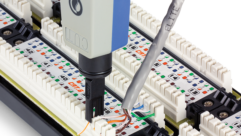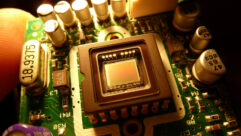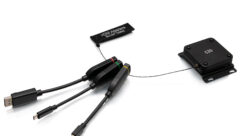Back to Basics
Apr 1, 1998 12:00 PM,
Andrew Dixon
The sound installation business these days is a hotbed of new technologieswith products and gadgets that have consumed our attention, and as aresult, the industry is hungry for the latest buzzword. The pages of thetrades are filled with sophisticated multizone, multisource systems. Theinstallation at St. Wilfrid of York Episcopal Church in Huntington Beach,CA, is neither. In fact, it is quite the opposite. This installationrepresents functional design simplicity, quick and effective installation,and a return to value and customer satisfaction.
St. Wilfrid’s is a church that has been operating in Huntington Beach forapproximately ten years. The original sound system in the church exhibitedsome serious deficiencies that were having a negative impact on thecongregation. In particular, the church pointed to a lack of a uniformsound quality throughout the entire building and inadequate speechintelligibility, both of which were a direct cause of declining attendance.
Lindes Electronics, Sante Fe Springs, CA, was consulted to presentsolutions to St. Wilfrid’s parishioners. The Lindes staff had been workingwith the church for some time doing maintenance and attempting to balancethe existing system, which eventually proved to be an exercise in futility.
David Kalb, principal of Lindes explained, “We were familiar with thesystem having worked on it over a period of two years, so when we went into assess the overall system performance in St.Wilfrid’s, we knew what toexpect. We had a strong sense of what the church was looking for and whatwe felt was needed to correct the problems. For the most part, the frontend, amp and signal processing equipment was adequate and in good workingcondition. The loudspeaker system at the time consisted of three mid/highhorns and three large woofers. The system was splayed at 90 degrees in anattempt to fill the seating area adequately. The ceiling of the churchfeatures a raised center directly above the congregation where theloudspeaker cluster is housed. The original system was actually hung about10 feet (3 m) higher than the original design called for due to a veryobtrusive and, frankly, ugly appearance. The loudspeakers wereunfortunately directed into the reverberant parallel sides of the raisedcenter in the ceiling, causing a lot of unwanted room reflections.Essentially, the loudspeaker section of the system was not able to providethe necessary coverage or intelligibility to meet the needs of the church.The visual aspect of this original loudspeaker section was a concern andwould continue to be for its replacement.”
The design team at Lindes developed two proposals they felt would solve theproblems at the church. The first proposal involved supplementing thecluster with additional devices to fill in the areas that lacked adequatesound coverage. This would be a reasonable solution based on budget alone,as the church did not have a large allocation of funds for this project.The fear, however, was that the disparity in sound quality between thedifferent models would be extremely distracting, and it would not solve thereal problem. A major request from the church was a uniform sound qualitythroughout the building.
The second proposal was the complete replacement of the loudspeakersection. This was the approach the church chose to pursue. The designLindes developed consisted of five Tannoy i12 Dual Concentric loudspeakers,clustered below the center rise in the ceiling.
Kalb explained, “The point source transducers were chosen for theirsuperior speech intelligibility characteristics. The coverage behavior ofthe devices is excellent, making placement much like an automaticcamera—just point and shoot, with little or no EQ.”
Two Tannoy CPA5 loudspeakers were mounted on the rear of the cluster toprovide coverage to the pulpit and altar areas. The CPA5 has a 5.25 inch(133 mm) point source ICT (Inductive Coupling Technology) transducer sothat the high frequency section cannot be burned out. The cluster wasrigged to the existing hardware framework mounted on the ceiling by theinstallation team of Allen Wheeler and Gary Evans.
Wheeler said, “We were able to suspend the loudspeakers from the aircraftcables low enough to get them down below the center rise that had causedproblems with the original system. We positioned the five-box array tocover the congregation, pulpit and altar seamlessly. The church didn’t wantto spend a lot of money changing out the front-end system, nor did theyneed to. The Tannoy i12 center cluster is powered by a Yamaha 200 W/ch ampworking with a Tannoy TX2 system controller. The Tannoy CPA5s are poweredby a TOA amp that was already in the rack. We put in a Sabine Feedbackeliminator and worked with the existing Ashly and Biamp mixers.
“To solve the aesthetic concerns of the church, the new loudspeakers andthe ceiling framework were all painted white. The array itself is verycompact, and with the white color and improved sound quality, the systemexceeded the congregation’s expectations.”
The entire job was designed in about four hours and installed over twodays, and the results are incredible. The installation is best summed up bya quotation from the church administrator, David Grover, in a letter toLindes following the completion of the installation in which he wrote,”Your suggestion that we install Tannoy loudspeakers as a total replacementsystem and to include monitor loudspeakers to cover the altar area hassolved most of our problems. The installation has solved the visualproblems of the large black loudspeakers hanging from a large black metalstructure. The all-white installation has made the loudspeaker system allbut invisible. In these days of corporate apparent lack of pride inworkmanship and customer support, you have bucked the trend. Your word hasbeen your bond, and we are always pleased with anyone who fully understandsthe word integrity.”










